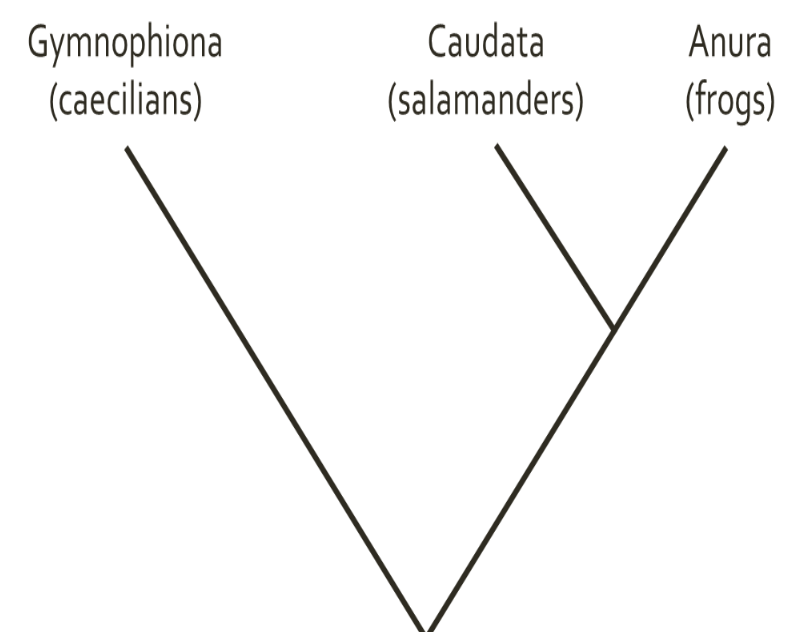Vertebrate Ecology Lecture One
1/41
There's no tags or description
Looks like no tags are added yet.
Name | Mastery | Learn | Test | Matching | Spaced |
|---|
No study sessions yet.
42 Terms
class amphibia
of phylum chordata
require water to reproduce
subclasses:
labyrinthodontia (extinct)
lepospondyli (extinct)
lissamphibia
subclass lissamphibia

“class” reptilia
of phylum chordata
adaptations for life on land
rough skin w scales
no distinct larval stage
breathe air
most lay eggs
4 extant orders:
Sphenodontia
• Crocodilia
• Testudines
• Squamata
class aves
of phylum chordata
feathers
adaptations for flight
class mammalia
of phylum chordata
hair
mammary glands
teeth
why move to land?
droughts
escape predation
open niches
adaptations for terrestrial living
respiration: air bladder → lungs
water loss: scales → specialized skin
reproduction: aquatic → non-aquatic
order anura
frogs
permeable skin
eggs require water
suborder neobatrachia
suborder neobatrachia
3 families
bufonidae - toads
hylidae - treefrogs
ranidae - true frogs
order caudata
salamanders
eggs require moist environment
permeable skin
suborder salamandroidea
suborder salamandroidea
4 families (at UNDERC)
ambystomatidae - mole salamanders
Plethodontidae - woodland salamanders
Proteidae – mudpuppies
Salamandridae – true salamanders
amniotes
Amniotic egg adaptation to decrease reliance on
aquatic habitats for reproductionIncludes reptiles, birds and mammals
order testudines
turtles
bony or cartilanginous shell
suborder cryptodira
chelydridae - snapping turtles
emydidae - pond turtles
order squamata
lizards and snakes
all have horny scales
movable quadrate bones - upper jaw movable
suborder scleroglossa
infraorder srppentes
infraorder serpentes
Lack legs, eyelids and external ears
- Internal fertilization
- Colubridae
Class Aves
BIRDS
columnbiformes
doves and pigeons
falconiformes
diurnal birds of prey
apodiformes
hummingbirds
gruiformes
cranes and rails
piciformes
woodpeckers
strigiformes
owls
anseriformes
ducks and geese
galliformes
chickens and turkeys
passeriformes
perching birds
feathers
made of keratin
insulation
flight
visual communication
camouflage
feather structure
Base of vane (afterfeather) → barbules lack
barbicels
- Outer part of vane→ barbules interlock
- Barbicels on distal side of barbules connect to adjacent barb
- Provide cohesion and flexibility
- Friction barbules
remiges
flight feathers
primaries: provide forward thrust
secondaries: provide lift
coverts
cover gaps between remiges
retrices
steering and braking
feather care - preening
Secretes oil composed of waxes, fatty acids, fat, water
• Preserves feather moistness and flexibility
• Important for insulation and waterproofing
• Regulate bacterial and fungal fauna
adaptations for flight
decrease overall weight
hollow spaces in bones
skeleton reinforced
support masculature for flight
furcula
flight muscles
large pecs
morphological trends of aves
jaw and teeth
masseter → stronger bite
secondary palate
chewing and breathing
appendicular girdles
hindlimbs move to parasagittal plane
body size
trend toward smaller body size
eulipotphyla
shrews and moles
chiroptera
bats
rodentia
rodents
carnivora
cats, dogs, bears, weasels
artiodactyla
ungulates
lagomorpha
rabbits
mammary glands
nourishment for young
water
protein
fat
sugars
vitamins and salts
hair
dead epidermal cells
keratin
Outer layer → cuticle scales
Cortex → contains pigments
Medulla → inner layer
Coat → pelage
Provides insulation
Molting
modern mammals
Single dentary bone
3 auditory ossicles
2 occipital condyles
Tympanic bone
Hair
Four-chambered heart
Enucleate erythrocytes
Mammary glands
Diaphragm